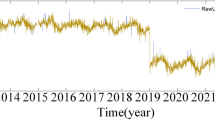Abstract
Analysis of spatiotemporal observations often leads to decomposition of the problem into a spatial part multiplied by a temporal part (factorization). Principal component analyses produce factors that are temporally uncorrelated but that remain spatially correlated, leading to incomplete factorization. Min–max autocorrelation factors developed many years ago are adapted here to ecological applications, leading to empirical orthogonal maps (EOMs). EOMs owe their name to the fact that they are indeed an enhancement of empirical orthogonal functions which extract the spatial patterns that explain most of the variability of a set of spatiotemporal observations indexed by time. Application on a time series of 61 scientific monitoring surveys targeting octopus distribution off the Mauritanian coast indicates that ten basic maps are sufficient to recover 68% of the total variability, and that the first two EOMs explain 38.4% of this variability. This manuscript clarifies the concept of orthogonality between factors in a spatial context. This provides the conditions for using Euclidean distance between spatial distributions, which in turn supports the reduction of a large set of spatial distributions into a small subset of basic spatial distributions explaining most of the variability within the set of input maps.






Similar content being viewed by others
References
Chilés J, Delfiner P (2012) Geostatistics, modeling spatial uncertainties, 2nd edn. Wiley, New York
Desbarats A, Dimitrakopoulos R (2000) Geostatistical simulation of regionalized pore-size distributions using min/max autocorrelation factors. Math Geol 32(8):919–942
Fujiwara M (2008) Identifying interactions among salmon populations from observed dynamics. Ecology 89(1):4–11
Gascuel D, Labrosse P, Meissa B, Taleb Sidi M, Guenette S (2007) Decline of demersal resources in north-west Africa: an analysis of Mauritanian trawl-survey data over the past 25 years. Afr J Mar Sci 29(3):331–345
Goovaerts P (1993) Spatial orthogonality of the principal components computed from coregionalized variables. Math Geol 25(3):281–302
Lindgren F, Rue H, Lindström J (2011) An explicit link between gaussian fields and gaussian Markov random fields: the stochastic partial differential equation approach. J R Stat Soc B 73(4):423–498
Lorenz E (1956) Empirical orthogonal functions and statistical weather prediction. Massachusetts institute of technology. Department of meteorology, Scientific report n1, Cambridge
MINES-ParisTech, RMINES (2021) Rgeostats: the geostatistical r package. http://rgeostats.free.fr/ Version: 12.0.0
Petitgas P, Renard D, Desassis N, Huret M, Romagnan JB, Doray M, Woillez M, Rivoirard J (2020) Analysing temporal variability in spatial distributions using min-max autocorrelation factors: sardine eggs in the Bay of Biscay. Math Geosci 52(4):337–354
Rondon O (2012) Teaching aid: minimum/maximum autocorrelation factors for joint simulation of attributes. Math Geol 44:469–504
Shapiro D, Switzer P (1989) Extracting time trends from multiple monitoring sites. Technical report SIMS 132. Department of statistics, Stanford University, California
Solow A (1994) Detecting change in the composition of a multispecies community. Biometrics 50(2):556–565
Switzer P, Green A (1984) Min–max autocorrelation factors for multivariate spatial imagery. Technical report SWI NFS 06, Department of statistics, Stanford University, California
Taylor L (1961) Aggregation, variance and the mean. Nature 189:732–735
Thorson J, Scheuerell M, Shelton A, See K, Skaug H, Kristensen K (2015) Spatial factor analysis: a new tool for estimating joint species distributions and correlations in species range. Methods Ecol Evol 6:627–637
Vargas-Guzman J, Dimitrakopoulos R (2003) Computational properties of min/max autocorrelation factors. Math Geol 29:715–723
Wackernagel H (2003) Multivarite geostatistics—an introduction with applications, 3rd edn. Springer, Berlin
Woillez M, Rivoirard J, Petitgas P (2009) Using min/max autocorrelation factors of survey-based indicators to follow the evolution of fish stocks in time. Aquat Living Resour 22:193–200
Acknowledgements
The authors would like to give deep recognition to the people working at the Institut Mauritanien de Recherche Océanographique et des Pêches—IMROP in Mauritania who organized the surveys, collected the raw data, and made the application possible.
Author information
Authors and Affiliations
Corresponding author
Ethics declarations
Conflict of interest
The authors disclose the absence of financial interests that are directly or indirectly related to the work submitted for publication.
Supplementary Information
Rights and permissions
Springer Nature or its licensor holds exclusive rights to this article under a publishing agreement with the author(s) or other rightsholder(s); author self-archiving of the accepted manuscript version of this article is solely governed by the terms of such publishing agreement and applicable law.
About this article
Cite this article
Bez, N., Renard, D. & Ahmed-Babou, D. Empirical Orthogonal Maps (EOM) and Principal Spatial Patterns: Illustration for Octopus Distribution Off Mauritania Over the Period 1987–2017. Math Geosci 55, 113–128 (2023). https://doi.org/10.1007/s11004-022-10018-w
Received:
Accepted:
Published:
Issue Date:
DOI: https://doi.org/10.1007/s11004-022-10018-w





